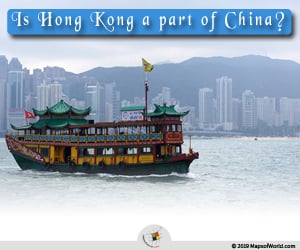

Hong Kong is administered as an SAR.
The People’s Republic of China (PRC) is the most populous country in the world with a population of over 1.4 billion people. It is also one of the largest countries by area. China is divided into 22 administrative provinces, 5 autonomous regions, and 2 special administrative regions (Hong Kong and Macau).
Hong Kong was a colony of the Great Britain for more than 150 years. While a part of the island came under the control of the British after a war in 1842, a 99-year lease of the New Territories was later given by the Chinese authorities. Under the British rule, Hong Kong prospered as a busy trading and manufacturing hub, and a magnet for the migrants. Until the year 1997, when the expiry of this lease led to a handover of Hong Kong to Chinese rule. As a Special Administrative Region (SAR), Hong Kong has since then been governed under the principle of “one country, two systems”. This means that the region has a high level of autonomy and maintains a separate administrative system. It also has a legal and judicial system which is different from the rest of PRC.
Hence, the reason why Hong Kong was administered as an SAR is intricately linked to its historic development as a colony of a major European nation. Hong Kong has its roots in a capitalist economic structure, western judicial principles, and civil liberties, while the rest of PRC was based on the revolutionary principles of communism and a one-party system. Even as Mainland China transformed into a market-based economy, the political principles governing the country remained firmly entrenched in communism. During the handover, Britain had negotiated vigorously with Beijing and secured for Hong Kong “a high degree of autonomy”, except in matters of foreign affairs and defence.
According to the handover agreement signed between Beijing and London in 1997, Hong Kong will be able to retain its autonomy till 2047 and be administered under the Hong Kong Basic Law. The Legislative Council of Hong Kong, the unicameral legislature of the SAR is semi-democratically elected, meaning that at least half its members are elected by popular choice. The Chief Executive of Hong Kong, the leader of the Legislative Council, is elected from a pool of candidates approved by the central government of the PRC. A 1200-member election committee, and a special electoral college formed of individuals and groups from Hong Kong’s 28 constituencies, participate in this election.
This process of the Chief Executive’s election has been a matter of much contention and sparked the 2014 Umbrella Revolution. Protestors occupied the streets of Hong Kong for about 79 days and demanded greater involvement of the local people in the election of the Chief Executive. However, they failed to achieve their objectives.
It is also important to understand that Hong Kong has always set itself apart from the rest of Mainland China. It is one of the world’s leading financial hubs and business centers. It is also a popular tourist and shopping destination. Hong Kong uses a different currency (Hong Kong Dollar) from the rest of the PRC (Chinese Yuan or the Renminbi).
Currently, Hong Kong is once again in the grip of a mass protest and demonstrations against Beijing’s plan to enforce an extradition plan. The new bill that the PRC is set to pass will make it incumbent on Hong Kong to detain and extradite people who are accused of certain crimes in Mainland China. So far, 37 different crimes have been detailed in this bill and this includes political crimes. Fears are that, if passed into a law, this will prompt a political witch-hunt. At present, mainland law enforcement authorities are not allowed to operate in Hong Kong. However, this extradition plan will allow the Chief Executive to approve transfer of any suspect to the mainland even if there is a basic case. This basically foils the very context of SAR Hong Kong having a separate legal and judicial system.
Hundreds of thousands of Hong Kongers are protesting what they consider an invasion of their autonomy and diminishing civil liberties. In a larger context, the plan has been viewed as a crackdown on the pro-democratic and liberal sentiments of Hong Kongers by President Xi Jinping who is known to be intolerant towards critics. The police of Hong Kong responded to the demonstrations by deploying tear gas and firing rubber bullet. Over 70 protestors are believed to have been hurt as yet. Most Hong Kongers see this as an attempt to crush the region’s autonomy, and eventually assimilate it as just another city in People’s Republic of China.
Related Links:
The Republic of Madagascar is an island country located in the Indian Ocean, off the…
The Euro is the official currency of the European Union. It is, however, not incumbent…
There are many countries or regions that are partially recognized by the UN, have disputes…
The Alaska Statehood Act was signed into law by President Dwight D. Eisenhower in 1958,…
The name Persia may, however, only be used to refer to Iran in some contexts.…
Hawaii is an Island State in the US. It is one of the 50 states…